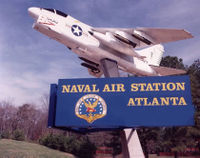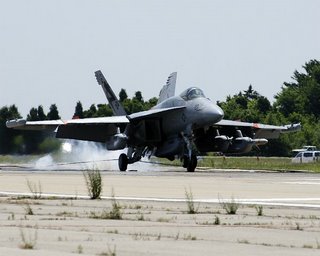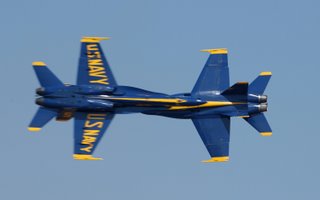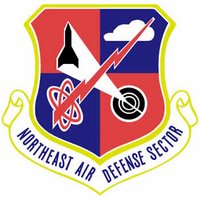
Press reports this morning are headlining a story on a terror plan to blow up commercial airlines in mid flight that has apparently been disrupted by Britain's Scotland Yard. Because the US DHS is not sure if the plot has been completely thwarted, they have raised the threat level to critical or red for flights from the UK to the US. The Associated Press is reporting that the terror threat appeared to be aimed at United, American, Continental and British Airways international flights.
Radio monitors can keep tabs on trans Atlantic aircraft traffic via the North Atlantic MMARA family of frequencies listed below. Be especially diligent of the LDOCF frequencies listed below. These ARINC frequencies could provide especially interesting monitoring.
North Atlantic Major World Aero Route HF Frequencies This aeronautical major world air route has a high concentration of military, airline, charter, and business aircraft crossing the Atlantic on a variety of routes within six sub-families.
Graphics showing the boundaries of each of the NAT sub-families is available courtesy of Risto Hirvomen via the following links:
NAT ABCEF MWARA GraphicNAT D MWARA GraphicNAT-A North Atlantic Family A:
This sub-family of frequencies is assigned to aircraft whose route or portion of route transits Gander, New York, Santa Maria and Shanwick areas, especially those aircraft flying routes with reporting point coordinates between 43N and 47N. During off peak periods, and when watch is reduced on other families, Family A will remain the primary assignment for aircraft flying southerly routes.
Frequencies: 3016.0 5598.0 8906.0 13306.0 17946.0 kHz (USB)
Ground Stations: Gander, New York, Santa Maria, Shanwick
NAT-B North Atlantic Family B:
This sub-family of frequencies is assigned to aircraft flying on eastbound or westbound tracks whose route or portion of route lies within the Gander, Iceland and Shanwick areas, particularly aircraft flying routes with reporting point coordinates between 47N and 64N. In order to ensure even peak-time distribution of traffic between Family B and C, aircraft may be assigned to either family on the basis of; state of registry, airline company or other such criteria as agreed between Shanwick Radio and Gander Radio.
Frequencies: 2899.0 5616.0 8864.0 13291.0 17946.0 kHz (USB)
Ground Stations: Gander, Iceland, Shanwick
NAT-C North Atlantic Family C:
This sub-family of frequencies is assigned to aircraft flying on eastbound or westbound tracks whose route or portion of route lies within the Gander, Iceland and Shanwick areas, particularly aircraft flying routes with reporting point coordinates between 47N and 64N. In order to ensure even peak-time distribution of traffic between Family B and C, aircraft may be assigned to either family on the basis of; state of registry, airline company or other such criteria as agreed between Shanwick Radio and Gander Radio.
Frequencies: 2872.0 5649.0 8879.0 11336.0 13306.0 17946.0 kHz (USB)
Ground Stations: Gander, Iceland, Shanwick
NAT-D North Atlantic Family D:
This sub-family of frequencies is assigned to aircraft whose route or portion of route lies within the Bodo, Gander, Iceland and Shanwick areas, particularly those aircraft flying routes with reporting point coordinates north of 62N.
Frequencies: 2971.0 4675.0 8891.0 11279.0 13291.0 17946.0 kHz (USB)
Ground Stations: Artic Radio, Bodo, Gander, Iceland, Shanwick
NAT-E North Atlantic Family E:
This sub-family of frequencies is assigned to aircraft whose route or portion of route transits New York and Santa Maria areas, especially those aircraft flying routes with reporting point coordinates south of 43N.
Frequencies: 2962.0 6628.0 8825.0 11309.0 13354.0 17946.0 kHz (USB)
Ground Stations: Canarias, New York, Santa Maria
NAT-F North Atlantic Family F:
This sub-family of frequencies is assigned to aircraft whose route or portion of route transits New York and Santa Maria areas, especially those aircraft flying routes with reporting point coordinates south of 43N.
Frequencies: 3476.0 6622.0 8831.0 13291.0 17946.0 kHz (USB)
Ground Stations: Gander, Shanwick
13306.0 kHz is shared between families A and C. 13291.0 kHz is shared between families, B, D and F. 17946.0 kHz is shared by all the families. 13354.0 kHz is shared with RDARA 5 and 7.
Based on basic HF propagation priciples, the following bands are used based on time of day.
2-8 MHz Night Propagation
9 MHz and higher Day Propagation
As a general rule, when assigning primary and secondary frequencies, ground station personnel will assign lower frequencies as primary and higher frequencies as secondary for aircraft flying away from the ground station. Conversely, for aircraft routing towards the station, the higher frequencies will be assigned as primary and lower frequencies as secondary.
Ground Station Frequency Profiles
Bodo Norway
2971.0 2983.0 4666.0 4675.0 6544.0 8840.0 8891.0 11279.0 kHz
SAR: 3023.0 5680.0 kHz
Gander Newfoundland, Canada
2872.0 2899.0 2971.0 3016.0 3476.0 4675.0 5598.0 5616.0 5649.0 6622.0 8831.0 8864.0 8879.0 8891.0 8906.0 11336.0 13291.0 13306.0 kHz
VOLMET: 3485.0 6604.0 10051.0 13270.0 kHz.
Reykjavik, Iceland
2872.0 2899.0 2971.0 4675.0 5616.0 5649.0 8864.0 8879.0 8891.0 11279.0 13291.0 13306.0 17946.0 kHz
Bohemia, New York
NAT: 2962.0 3016.0 5598.0 6628.0 8825.0 8906.0 11309.0 13306.0 13354.0 17946.0 17952.0 21964.0 kHz
Caribbean-A CAR-A: 2887.0 5550.0 6577.0 8846.0 11396.0 13297.0 kHz
Caribbean-B CAR-B: 3455.0 5520.0 6586.0 8918.0 11330.0 17907.0 kHz
VOLMET: 3485.0 6604.0 10051.0 13270.0 kHz
LDOCF: 3494.0 6640.0 8933.0 11342.0 13330.0 17925.0 kHz
Santa Maria, Azores
2962.0 3016.0 5598.0 6628.0 8825.0 8906.0 11309.0 13306.0 13354.0 17946.0 kHz
Shanwick, Shannon, Ireland
2872.0 2899.0 2971.0 3016.0 3476.0 4675.0 5598.0 5616.0 5649.0 6622.0 8831.0 8864.0 8879.0 8891.0 8906.0 11336.0 13291.0 13306.0 kHz
SAR: 2182.0 3023.0 5680.0 kHz
VOLMET: 3413.0 5505.0 8957.0 13264.0 kHz
The best online guide I have seen on this that will answer many questions is at:
NAT-HF Guidance. You should download this and study it to understand completely the NAT MWARA system.


















